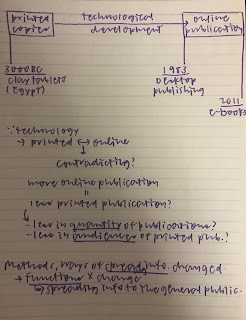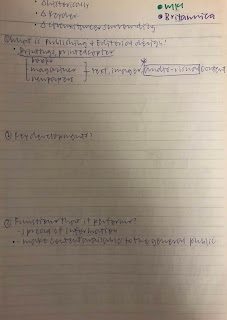Wednesday, 28 November 2018
Tuesday, 27 November 2018
TYPE, TYPOGRAPHY AND PRINTING
Type, typography and printing
- Didn’t have strict division in job roles
- Identifying in needs àputting skills and techniques together to resolve that need
- About craft and craftsmanship
- How people use craft in making physical metal type form
- Type styles reflects political and religious issues
- Take paper production for granted
- Papers developed and refined
- 1960s photographic production
- Letterpress movable type
Type= part of printing and reproduction process
Craft, communicate, distribute ideas
Styles and evolution of type
1stmovable type:
Bastarda by Johannes Gutenberg (style: blackletteràmimicking scribble handwritings)
àreflecting handwritten calligraphy
àrough
Printing press in communication and distributing ideas was profound
Jenson by Nicoloas Jenson (Style: roman/ serif)
àstyle reflects on roman architecture
- refine them to make it function better on the page, easier to make
- maintain consistency
àchanges how people engage in written languages
àprinted words start to influence language and writing
Griffo Italic
Italic for emphasis
Created to be use exclusively
Taking less place in writing cursive
Fraktur (blackletter)
àChristianity
àused by the Nazis
Garamond Roman (roman/serif)
àmore refined
àmore precise version using more developed techniques of founding typefaces
àpacked
Baskerville (transitional/ serif)
àtransitional typefaces: post medieval Europe to modern Europe (pre-industrial revolution)
àused in publication about rational truth to be found within nature
àdelicate, elegant precise
Bodoni (“modern”/ serif)
àpre- industrial revolution
Figgins’ Antique (slab serif/ display type)
àpublic awareness notices, posters
àelegant serif form, expanded
Thorowgood’s grptesque (Sans serif(gothic)(/ display)
àexperimented with removing the serifs of typefaces
àinadequate, clumsy, weren’t readable
Clarendon (slab serif/ display typeface)
àelegant serifs and curves
àMore decorative and appealing
àmost successful grostesque typeface
Franklin Gothic (sans-serif/ grostesque)
àdesigned to be used in newspapers, magazines, advertising
àowing to functionality, clarity (modernity)
Avant Garde (Sans-serif/ geometric)
àto compliment the photosetting technologies
àgeometric typeface
àjoined up characters
Verdana (sans-serif/ digital)
àlate 1980s computers were developed
àquicker and more efficient
àwork specifically for computer screens
àboring typeface with no character
Task
bring 2-3 images that relates to the things that you've been reading in relations to the topics
Tuesday, 20 November 2018
STRUCTURE
STRUCTURE
TYPOGRAPHY
Chronological
Introduction (this essay will discuss this, using these sources and presenting these conclusions) àsimple
key development (printing, history)
key development (modernity, changes)
key development (the internet, computer, technologies)
summary/ conclusion
Introduction
Key theme (historically structure)
ADVERTISING(gender in historical timeline in relation to adv)
BRANDING(effects of WWII changed consumers lifestyles)
Key theme (historically structure)
Summary/ conclusion
Key developments/ themes
+
Contexts
= political, social, cultural, technological
Monday, 19 November 2018
WRITING AND CITING
Printed materials are presenting images and text along with different typography, layouts, grids and composition and specific arrangements that convey the desired message in a specific way to enhance and achieve the intended message for the readers in an effective and efficient manner. (Jamie 2013) Editorial design plays a key role in the way information is presented, shared and understood — and, in performing this last function, this discipline can bring transcendental change to society. (Laura Busche) As seen, publications and editorial designs are so important that graphic designers should actually have a wider knowledge of the most influential events of them.
Tuesday, 6 November 2018
SUSTAINABILITY + STARTING RESEARCH
Economic, environment, social à sustainable development
ENVIRONMENTAL SUSTAINABILITY
Development which seek to sustain the resources that the planet is providing for us
SOCIAL SUSTAINABILITY
Sustaining positive social relations and social engagement in a society or community or even globally
Sustainable products
ECONOMIC SUSTAINABILITY
Economy in a broader sense (national, global)
Challenging to sustain
Sustain economic well being
CULTURE
Part of social sustainability
Inform society, social relations
*How the things we produce encourage sustainable development
WASTE
Energy consumption
Waste management
Filtered and recycled
Incinerators in Leeds
As designers:
àmake contributions to sustainability
àobvious voice in society in terms of communicating with people
How much ink u use for the typeface?
Climate change
Social awareness
STARTING RESEARCH
EDITORIAL AND PUBLICATIONS
1stessay
General definition
Key development= choose important history to talk about
What are you looking for?
Establish questions and sub themes
*a definition for your topic*
*key developments in…*
Consider search terms
Editorial design àa term that we know
àthink about translating these into term that we use in search engines…
Publishing, print, web media, news platforms, magazines
**SEARCH TERMS**
“xxx”, “history of xxx”, “what is xxx”
Consider resources
GOOGLE
Evaluating reliability of what you are looking at online
References to other sources
Who produces information on online
Uni websites (.ac.uk) àreliable
.edu (US unis)
News platforms
àCreatorview
àimagazine
With the author nameàreliable
Wikipedia ànot really reliable
àgeneral start of information only
Portal àlibrary àsearch
Text books, history of…, how to…, what is…
“readers”, complex monographs, very specific monographs
JSTOR
GOOGLE BOOKS
GOOGLE SCHOLAR
HARVARD REFERENCING
This person said xxx, however who said xxx, who debated xxx
Keeping a log of resources/ references
tables
Mind maps
1. Establish research aims (definition)(key dev)
2. Find sources
3. Browse, scan, skim, search (index)
4. Read! (look up words!)
5. Write bullet-point short summaries (what the author said in defining, in highlighting the key development…)
6. Avoid just collecting quotes. They will not tell the whole story out of context
7. Arrange your findings on a table, chart, mind-map
Offer a broad definition and key developments of your topic.
Ensuring that you also answer the most important question: “says who?”
Assumption
à use various sources to prove your assumption
research aims:
significant changes in the publishing history
find sources:
https://www.joshtong.io/blog/2014/10/21/what-is-editorial-design-and-why-is-it-so-important-to-digital-publishing
http://www.designishistory.com/design/editorial-design/
http://guity-novin.blogspot.com/2012/04/modern-newspaper-magazine-layouts.html
https://www.propublica.org/podcast/the-evolution-of-editorial-design-and-visual-storytelling
https://anm102pm.files.wordpress.com/2010/09/anm102-session04-graphic-design-and-the-industrial-revolution1.pdf
http://history.kimnanhee.com/wp-content/uploads/2015/08/GD_History_Chapter9_Class.pdf
https://pschmill.wordpress.com/2012/09/24/industrial-revolution-and-the-printing-press/
avoid collecting quotes without your own interpretation/input.
Subscribe to:
Posts (Atom)
Ideas development
IDEAS DEVELOPMENT Is art direction the most important sector in fashion branding? (Do customers really care about the concept behind e...
-
MAIN APPROACH I wanted to apply elements used in propaganda and create a campaign to promote Hong Kong culture. There are a lot of un...
-
BRIEF BRIEF Title SCAN Magazine Background Focusing on online magazine readers, it is shown in research that they are eager t...
-
- liked the aesthetic n how the colours worked well - looks "carhartt" - incorporate the qr code into part of the design - usin...








